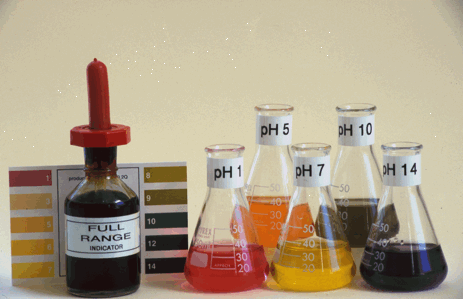|
Chemguide: Core Chemistry 14 - 16 pH and indicators This page introduces the pH scale to measure the degree of acidity or alkalinity of a solution. It also introduces some common ways to test whether a solution is acidic or alkaline. The pH scale The pH scale is used to measure the acidity or alkalinity of a solution. The key points are:
If a solution has a pH of less than 7, it is said to be acidic. So an acidic solution is one with a pH less than 7. If a solution has a pH higher than 7, it is said to be alkaline. So an alkaline solution is one with a pH greater than 7. Indicators Indicators are substances which change colour depending on the pH of a solution. They can be in solution or as papers soaked in solution and then dried. The most familiar one is litmus. Litmus paper Litmus is nearly always used as litmus paper rather than a solution. It comes in two forms - red litmus and blue litmus.
Alkalis turn A disadvantage of litmus is that its colour change isn't very sharp - it changes colour over quite a wide range of pHs - from pH 4.5 to pH 8.3. In between it is various shades of purple. So if it is turns red, all you can say is that the pH of what you are testing is 4.5 or less. If it turns blue, all you can say is that the pH is 8.3 or greater. Nevertheless, it picks out most acids and alkalis, and is easy to use. Universal indicator This is a mixture of indicators which change colour at all sorts of different pHs. The commonest form is known as full-range universal indicator, and changes colour in a regular way from pH 1 to pH 14.
You don't remember these colours - you just compare the colour you get with the colour on the chart which accompanies the indicator paper or solution. The results aren't particularly accurate. It is also possible to get narrow-range indicators which cover a much smaller range of pH more accurately. pH meters To measure the pH accurately, you can use a pH meter which has a probe which you simply put into your solution and get a digital read-out of the pH. Ideally, the pH meter is adjusted before use by putting the probe into a solution of accurately known pH - for example, pH 4.0 or pH 10.0. The meter is then adjusted so that it reads exactly 4.0 or 10.0.
© Jim Clark 2020 |
